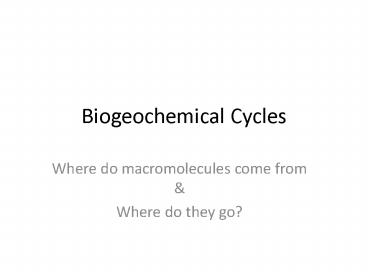Biogeochemical Cycles PowerPoint PPT Presentation
1 / 28
Title: Biogeochemical Cycles
1
Biogeochemical Cycles
- Where do macromolecules come from
- Where do they go?
2
Elements transferred between compartments (pools)
- Active accessible to living things
- Storage inaccessible
3
Biogeochemical Cycle Overview
4
What is a Biogeochemical Cycle?
- Reuse of materials in ecosystem by living
organisms - Biological components (biotic)
- Producers
- Consumers
- Detritivores (scavengers decomposers)
- Geological components (abiotic)
- Atmosphere (gases water vapor)
- Solid crust of the earth (minerals chemicals)
- Earths water (oceans, lakes rivers)
5
Biogeochemical Cycles
- Water needed to make CARBOHYDRATES, LIPIDS,
PROTEINS
6
THE WATER CYCLE
7
(No Transcript)
8
Other Biogeochemical Cycles
- Water cycle
- Carbon needed to make CARBOHYDRATES, LIPIDS,
PROTEINS, NUCLEIC ACIDS
9
CARBON CYCLE
atmosphere
photosynthesis
respiration
biosphere
10
CARBON CYCLE
11
CARBON CYCLE
atmosphere
photosynthesis
combustion
respiration
biosphere
12
(No Transcript)
13
Other Biogeochemical Cycles
- Water cycle
- Carbon cycle
- Nitrogen needed to make PROTEIN NUCLEIC ACIDS
14
Nitrogen Cycle
atmosphere
loss
fixation
gain
denitrification
biosphere
15
Nitrogen Cycle
- Despite abundance in the atmosphere (77 of
Earths atmosphere made of N2 gas) nitrogen is
actually a limiting factor to plant growth - Most organisms cannot use elemental N2 and must
use nitrogen present in soil minerals - N2 gas is fixed into these nitrogen compounds
mainly by bacterial processes
16
Stages of Nitrogen Cycle
- Ammonification
- Most soil nitrogen is result of decomposition of
nitrogenous compounds by bacteria (amino acids,
proteins, etc.) - These bacteria release excess nitrogen in the
form of ammonia (NH3) or ammonium ions (NH4)
17
Stages of Nitrogen Cycle
- Ammonification
- Nitrification (by nitrogen-fixing bacteria)
- Several species of bacteria able to oxidize
ammonia to get energy for metabolism - Although nitrite (NO2-) is toxic, it is quickly
changed to nitrate (NO3-) by another group of
bacteria - Most plants take up nitrogen in the form of
nitrate
2NH3 3O2 ? 2NO2- 2H 2H2O
2NO2- O2 ? 2NO3-
NITRATE
18
Stages of Nitrogen Cycle
- Ammonification
- Nitrification
- Assimilation
- Requires energy expenditure to attach ammonium
ions to carbon-containing compounds - Amino acids produced
- Amino acids form PROTEINS
19
Loss of Soil Nitrogen
- Nitrates steadily lost from cycle by
- Harvesting plants
- Soil erosion
- Fire
- Leaching
- Denitrifying bacteria these break down nitrate
into N2 gas (in the absence of oxygen) usually
takes place in poorly drained soil
20
(No Transcript)
21
NITROGEN CYCLE ANIMATION
22
(No Transcript)
23
Other Biogeochemical Cycles
- Water cycle
- Carbon cycle
- Nitrogen cycle
- Phosphorus needed to make DNA RNA (nucleic
acids) as well as ATP (the energy currency of
cells)
24
(No Transcript)
25
PHOSPHORUS CYCLE
26
Other Biogeochemical Cycles
- Water cycle
- Carbon cycle
- Phosphorus
- Sulfur needed to make certain proteins
27
SULFUR CYCLE
28
QuestionsWhat would happen if a biogeochemical
cycle slowed down or sped up?What might
cause such a thing to happen?
- Turn to your neighbor and explain. Then write a
summary of what you both concluded.

